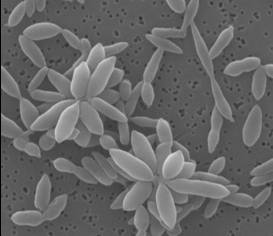Roseobacter projectThe purpose of the project is to determine the mechanisms that govern the interaction between some of the tiniest but most abundant marine organisms; the microorganisms. We will focus on a particular group of bacteria, the so-called Roseobacter group, which is the most abundant group in the ocean microbiota. We will determine their importance in nutrient turnover and microbial balance in the oceanic environment. We will focus on the Roseobacter production of secondary metabolites. These compounds are typically lethal to other microorganisms and may be a key to the success of the Roseobacter group in the ocean environment. Also, this bacterial group plays an important part in nutrient turn-over in the ocean and their production of gas-soluble substances is important in cloud formation and, hence, in the global climate. The antibacterial compounds produced by the Roseobacter-group are likely to play a major role in their own and in the ocean ecology. Also such compounds are likely candidates for development of novel antibiotics and other antimicrobial compounds with a wide range of applications – in the clinical sector, in horticulture and animal production as well as in food and biotech processing.
The project group consists of several participants and covers a broad range of required expertice: microbial ecology, marine natural product chemistry, mammalian cell assays and molecular microbiology. Lone Gram and Jesper B. Bruhn are from the Danish Institute for Fisheries Research. Thomas O. Larsen, Jørn Smedsgaard and Kristian F. Nielsen and Ellen Kirstine Lyhne are from Center for Microbial Biotechnology and Michael Givskov is from Center for Biomedical Microbiology all at at BioCentrum, DTU. Mads G. Johnsen, Flemming Jørgensen, Lars H. Pedersen and Kim Holmstrøm are employed at Bioneer A/S, and Carsten Christophersphersen is from the Department of Chemistry and Copenhagen University.
The research group responsible for chemical characterisation of biologically active compounds is world re-known for their work on terrestrial filamentous fungi, such as Penicillium and Aspergillus, both genera that are notorius for their production of bioactive compounds for instance penicillin. Therefore, we will also as part of the work collect marine filamentous fungi, and this will give us a unique chance to compare the properties of marine versus terrestrial fungi. It is still controversial whether many of the fungi described as being marine are indeed just terrestrial fungi that have been blown into the sea. In either case a lot of new species and bioactive compounds are likely to be discovered.
|
Figur 1
When grown under particular conditions, some Roseobacter bacteria will grow as rosettes. Only under these conditions do the organism produce its antibacterial compounds |
 |
|
|
|